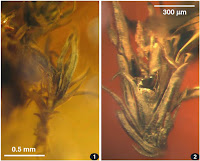The
Hengduan Mountains form the southeastern tip of the Himalayas,
stretching from eastern Sichuan Province through northern Yunnan and
southeaster Tibet into southern Myanmar. The range comprises a series
of parallel north-south mountain ridges with south-flowing rivers
between. The area is considered to be one of the world's biodiversity
hotspots, with sharp divisions in flora and fauna both between the
valleys of the range and at different altitudes on the mountains,
leading to a very high number of endemic species.
In a
paper published in the journal Phytotaxa on 21 September 2016, Juan
Jiménez
of the Departamento de Biología Vegetal (Botánica) at the
Universidad de Murcia, David Long of the Department of Botany at the
California Academy of Sciences, James Shevok of the Royal Botanical Garden iEdinburgh and Juan Guerra, also of the Departamento de
Biología Vegetal (Botánica) at the Universidad de Murcia, describe
a new species of Moss from the Hengduan Mountains of Sichuan and
Yunnan provinces.
The
new Moss is placed in the widespread and specious genus Didymodon,
and given the specific name
hengduanensis,
meaning 'from Henduan'. The species is described from five specimens
from Lushu, Heqing, Gongshan, and Shangri-la counties in Yunnan
Province and Yajiang County in Sichuan Province, collected by Davd
Long and James Shevock during a series of joint expeditions with the
Chinese Academy of Sciences. The moss grows in dense tufts reaching
3.7 cm in height, and yellowish green in colour. It is distinguished
from other Mosses in the genus Didymodon
by its long, pointed leaves and by the presence of a leaf margin,
made up of cells distinct from those of the rest of the leaf.
Habit
of Didymodon
hengduanensis
in dry state. Jiménez
et al.
(2016).
See also...
 Didymodon novae-zelandiae: A new species of Moss from Manukau Harbour, New Zealand. Mosses are among the simplest and most ancient groups of plants. They
lack flowers, seeds and roots, and only have very simple vascular
systems...
Didymodon novae-zelandiae: A new species of Moss from Manukau Harbour, New Zealand. Mosses are among the simplest and most ancient groups of plants. They
lack flowers, seeds and roots, and only have very simple vascular
systems... Mosses from Late Eocene Rovno Amber. Mosses are thought to be among the most ancient of plant groups, and
still make up a significant proportion of all plant communities. They
are an ancient group, considerably predating vascular plants such as
Ferns and Seed Plants, but they have a poor fossil record, largely due
to their lack of...
Mosses from Late Eocene Rovno Amber. Mosses are thought to be among the most ancient of plant groups, and
still make up a significant proportion of all plant communities. They
are an ancient group, considerably predating vascular plants such as
Ferns and Seed Plants, but they have a poor fossil record, largely due
to their lack of... Two new species of Moss from the Permian of Brazil. Mosses (Bryophytes) are simple plants which lack vascular systems to
pump water and nutrients from a root system, instead relying on what
they can absorb through their leaves, and generally only reaching a few
cm in height. This means that they...
Two new species of Moss from the Permian of Brazil. Mosses (Bryophytes) are simple plants which lack vascular systems to
pump water and nutrients from a root system, instead relying on what
they can absorb through their leaves, and generally only reaching a few
cm in height. This means that they...
Follow Sciency Thoughts on Facebook.

